|
Week 7: September 12 - 18, 2010 |
Welcome
to the McGill Bird Observatory weekly report.
Click here for a complete listing of our archives.
Comments or
questions are welcome at "mbo AT migrationresearch.org".
|
PICTURE
OF THE WEEK: |
|
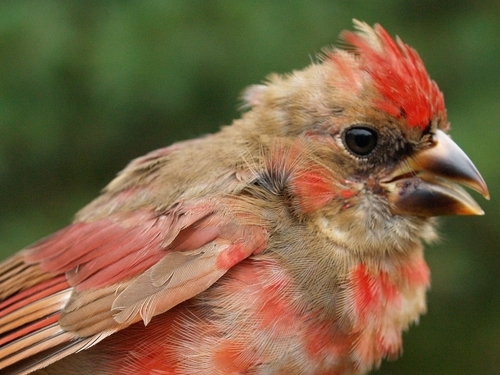
In the midst of all the many neotropical migrants banded at MBO this week was this
rather scruffy hatch-year male Northern Cardinal, likely a local bird. It is just beginning
to acquire its red plumage through the preformative molt, and the molt limits on the wings
are distinctly visible even from this angle.
(Photo by Simon Duval)

|
MBO
gratefully acknowledges the fundraising efforts of CCFA (Centre de Conservation de la Faune Ailée) in support of MBO - drop in at the store or click on the logo at left to visit the website for details on bird posters for sale with proceeds benefiting MBO.
|
|
|
|
THIS WEEK |
THIS FALL |
2010 TOTAL |
SITE TOTAL |
|
# birds (and species) banded |
297 (42) |
1779 (64) |
2654 (75) |
26163 (105) |
|
# birds (and species) repeat |
60 (22) |
278 (31) |
492 (45) |
4833 (67) |
|
# birds (and species) return |
6 (3) |
27 (15) |
159 (31) |
779 (37) |
|
# species observed |
87 |
118 |
152 |
202 |
|
# net hours |
532.0 |
3603.0 |
7162.4 |
47069.6 |
|
# birds banded / 100 net hours |
55.8 |
49.4 |
37.1 |
55.6 |
|
|
Note: table does not include nocturnal banding (owls) |
|
Bander-in-charge: Simon Duval, Lance Laviolette
Assistants: Veronica Aponte, Christine Barrie, Nancy Boily, Chantal Cloutier, Jane Cormack, David Davey, Amélie Drolet, Andrée Dubois-Laviolette, Philippe Dunn, Gay Gruner, Marie-France Julien, Kristen Keyes, Meghan Laviolette, Chris Murphy, Catherine Russell, Melissa Scerbo, Charles Séguin, Katie St-Jean, Alex Stone, Patricia Stotland, Rodger Titman, Élodie Vajda
Notes: Hard to believe, but this week already marked the middle of our 2010 fall migration monitoring program. As has been the case throughout the season, we banded an above average number of birds for the week, though this time we missed the weekly record by a fair bit. Unlike last week where the spike of 172 birds banded on September 9 had a big influence on the weekly total, this week was more consistent, with between 21 and 42 birds banded most days, and the high totals being 60 to start the week, and 74 on Thursday. Our cumulative total for the season is nearly 50% higher than last year, and remains over 300 ahead of the best previous fall.
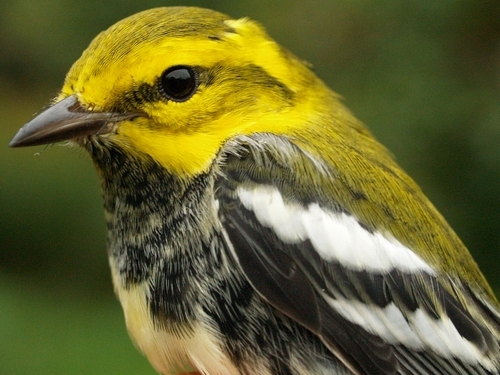
This is the second week in a row that we have featured a Black-throated Green Warbler, but with an after-hatch-year male as handsome as this, we couldn't pass up the opportunity - note how much more black there is in the throat compared to the hatch-year male featured as last week's bird of the week.
(Photo by Simon Duval)
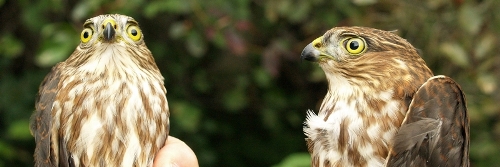
It is turning out to be a good season for Sharp-shinned Hawks at MBO. Catching two at once was unusual enough, but our total of 4 for the week was more than in some entire previous years, and the running total of 8 this fall is a new record high..
(Photo by Simon Duval)
|
As tends to be the case by mid-fall, we started seeing some of the later migrants, and as such our list of additions for the season (and for the year) is a long one this week. Birds observed for the first time this year were Greater Yellowlegs and Peregrine Falcon; an additional nine species were new for the fall 2010 list: American Bittern, Double-crested Cormorant, Killdeer, Ruby-crowned Kinglet, Golden-crowned Kinglet, Wood Thrush, Hermit Thrush, White-crowned Sparrow, and Rusty Blackbird. Even so, the season total of 118 remains slightly below the range of 119 to 123 at this point in previous years - though the 87 species observed during the week was unusually high, second only to the 90 species in week 7 back in 2005, but well above the range of 72 to 76 in other years. In all previous years, the first White-crowned Sparrows have arrived with remarkable consistency in week 8, so it was a surprise to see them already; similarly Golden-crowned Kinglets typically arrive in week 8 and Hermit Thrushes in week 8 or week 9. All of that would seem to suggest migration is earlier this year, but then we usually get Ruby-crowned Kinglets beginning in week 6 and they didn't start arriving until this week, so the signal is a bit mixed.
The changing of the seasons was also evident among the birds banded, with the total of 42 species this week being above average for this time of year. Winter Wren, Golden-crowned Kinglet, and Hermit Thrush were banded for the first time this year, while Brown Creeper, Ruby-crowned Kinglet, and White-crowned Sparrow were new additions for fall 2010. Also of note, we had our first ever repeat of a Western Palm Warbler (usually they move through quickly), and our first Rose-breasted Grosbeak return of 2010, a female banded on September 19, 2007, and not recaptured again until this week on September 15.
This week’s top 10 [last year's rank for this week in brackets]
# individuals banded |
mean # individuals observed daily |
1. Magnolia Warbler (46) [1] |
1. American Crow (84.7) [1] |
2. Yellow-rumped Warbler (27) [-] |
2. Canada Goose (46.1) [-] |
3. White-throated Sparrow (25) [-] |
3. Common Grackle (32.1) [10] |
4. Nashville Warbler (22) [2] |
4. Blue Jay (31.7) [3] |
5. American Goldfinch (17) [-] |
5. Black-capped Chickadee (25.6) [2] |
6. Red-eyed Vireo (15) [6] |
6. American Goldfinch (18.6) [6] |
7. Tennessee Warbler (11) [6] |
7. White-throated Sparrow (17.1) [9] |
8. Swainson's Thrush (9) [-] |
8. European Starling (11.1) [-] |
9. Black-capped Chickadee (8) [-] |
9. American Robin (10.9) [7] |
9. Black-throated Blue Warbler (8) [-]
9. Common Yellowthroat (8) [5]
9. American Redstart (8) [4]
|
10. Cedar Waxwing (9.6) [4]
|
|
Magnolia Warbler remained the most banded species for a fourth week in a row, exactly like in 2008. The season total now stands at 230 individuals banded, far ahead of Song Sparrow (152) and American Redstart (147) for the lead among species, but still a bit short of the record count of 264 banded in 2008. That year Magnolia Warblers tapered off quite rapidly after week 7, so it will be interesting to see how this year compares, especially with an apparent early influx of species typical of later fall. Also of note from a historical perspective, it was in 2008 that we experienced a huge influx of Yellow-rumped Warblers, but they didn't arrive in any numbers until week 8, so their presence in second place already this week may be a sign that we have a big movement headed our way again. White-throated Sparrow also jumped on the list this week, which is around the normal time of year for it to become among our most prominent species. On the whole, warblers were still dominant this week, with another five species making the top ten, but other mid/late season additions made their presence known this week too, most notable American Goldfinch, Swainson's Thrush, and Black-capped Chickadee. Both Common Yellowthroat and Tennessee Warbler are within three individuals of joining the list of warblers with a record count this year.
American Crow was the most frequently observed species this week, retaining that position from week 6 and also matching its rank for three of the past four years at this time of fall. Canada Goose usually reaches the top two in either week 7 or week 8, so the increase in numbers this week was right on schedule. The only other addition to the list this week was European Starling, while the two warblers from last week (Magnolia and Western Palm) dropped off, and Yellow-rumped Warblers haven't yet build up to large enough numbers to crack the top ten, though we expect that to change next week. The remaining species shuffled places to various extent, with the most noteworthy change being the drop of Blue Jays to fourth place despite an increase in numbers - the mean daily count of nearly 32 individuals actually represents the second highest weekly count we've ever had, behind only week 9 in 2005. To date, Blue Jay numbers have always peaked in either week 8 or week 9, so larger flocks may yet be headed our way before the end of the month.
|
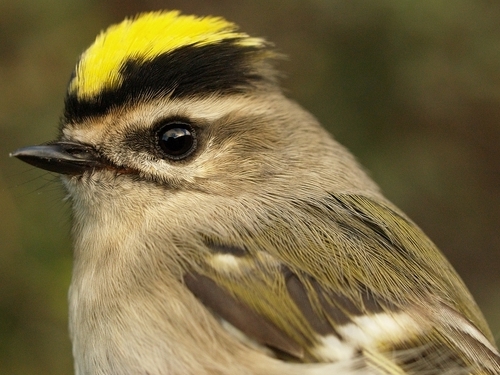
Our first Golden-crowned Kinglet of the fall, a sure sign of the season advancing.
(Photo by
Simon Duval)
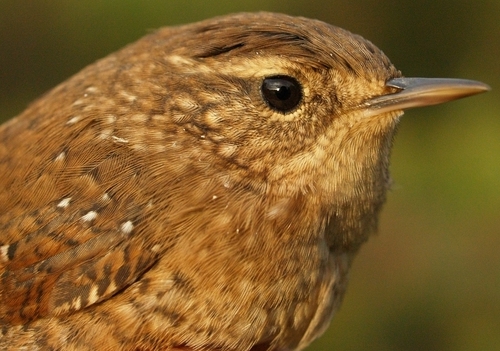
Winter Wren, another typical mid/late fall species at MBO.
(Photo by Simon Duval)
|






